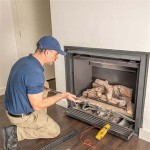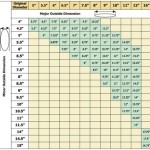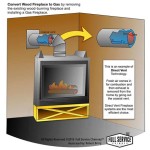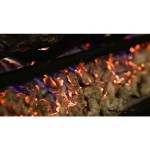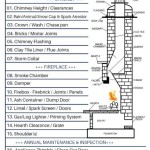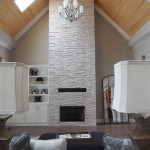Stick-On Tiles for Fireplace Surrounds: An Informative Guide
Fireplaces serve as focal points in many homes, offering both aesthetic appeal and functional warmth. Over time, fireplace surrounds can become outdated, damaged, or simply no longer aligned with a homeowner's desired aesthetic. Renovating a fireplace can be a costly and time-consuming endeavor, often involving professional contractors and significant disruption to the household. Stick-on tiles offer a potentially more convenient and cost-effective alternative for updating the look of a fireplace surround. This article explores the use of stick-on tiles for fireplace surrounds, examining their suitability, application process, limitations, and key considerations.
Understanding Stick-On Tiles
Stick-on tiles, also known as peel-and-stick tiles, are thin, lightweight tiles adhered to a substrate via a strong adhesive backing. They are typically constructed from materials such as vinyl, gel, or composites, designed to mimic the appearance of traditional ceramic, glass, or stone tiles. The primary advantage of stick-on tiles is their ease of installation, requiring minimal tools and expertise compared to traditional tiling methods. This characteristic makes them appealing for DIY projects and home renovations where speed and simplicity are prioritized.
Furthermore, stick-on tiles are generally less expensive than their traditional counterparts, reducing the overall cost of a fireplace makeover. They are available in a wide variety of colors, patterns, and textures, allowing homeowners to achieve a diverse range of design styles, from modern and minimalist to rustic and traditional. The tiles are often designed to be cut with a utility knife or scissors, facilitating customization and fitting around irregular shapes.
However, it's important to recognize that stick-on tiles are not a universal solution for all fireplace renovation projects. Their suitability depends on several factors, including the existing fireplace surround material, the proximity to the firebox, and the desired longevity of the renovation. Careful consideration of these factors is crucial before proceeding with a stick-on tile installation.
Assessing Fireplace Suitability for Stick-On Tiles
Prior to purchasing and installing stick-on tiles, a thorough assessment of the fireplace surround is essential. The existing surface must be clean, smooth, and structurally sound. Any loose paint, crumbling mortar, or uneven surfaces will compromise the adhesion of the tiles and can lead to premature failure. The surface should be prepped by thoroughly cleaning it with a degreasing agent and repairing any imperfections with a patching compound.
A critical factor to evaluate is the material of the existing fireplace surround. Smooth, non-porous surfaces like painted drywall, existing tile, or metal typically provide a better surface for stick-on tile adhesion compared to rough or porous materials such as brick or unfinished concrete. If the existing surface is porous, a primer specifically designed to enhance adhesion may be necessary.
Heat Resistance and Fire Safety: This is arguably the most important consideration. Not all stick-on tiles are created equal, and many are not designed to withstand the high temperatures generated by a fireplace. It is imperative to verify the heat resistance of the chosen tiles and ensure they are rated for use around fireplaces. Specifically, the tiles should be installed a safe distance away from the firebox opening where direct flames or intense radiant heat are present. The manufacturer's specifications will outline the maximum temperature the tiles can withstand and any recommended installation guidelines regarding proximity to heat sources. Using non-heat-resistant stick-on tiles near a fireplace can pose a significant fire hazard, potentially leading to melting, warping, or even combustion. In such cases, consider using traditional tiles that are specifically designed for fireplace surrounds.
Local building codes should also be consulted to ensure compliance with fire safety regulations. Some jurisdictions may have specific requirements regarding the materials used in fireplace surrounds, and it is the homeowner's responsibility to adhere to these regulations.
If there is any doubt about the suitability of stick-on tiles for a particular fireplace, it is always advisable to consult with a qualified fireplace installer or contractor. They can assess the specific conditions of the fireplace and provide expert guidance on selecting appropriate materials and ensuring safe installation practices.
Installation Process: A Step-by-Step Guide
The installation process for stick-on tiles is generally straightforward, but meticulous attention to detail is crucial for achieving a professional-looking and long-lasting result. The following steps outline a typical installation procedure:
- Preparation: Ensure the fireplace surround surface is clean, dry, and smooth. Remove any loose debris, grease, or existing coatings. Repair any imperfections with a patching compound and allow it to dry completely. Apply a primer if necessary, based on the manufacturer's recommendations and the porosity of the existing surface.
- Measurement and Planning: Carefully measure the area to be covered with stick-on tiles. Create a layout plan to determine the placement of the tiles, taking into account any existing features or architectural details. Use a level and measuring tape to ensure accurate alignment. Consider the grout lines, if applicable, and decide whether to use tile spacers for consistent spacing.
- Cutting and Fitting: Most stick-on tiles can be cut to size using a utility knife or heavy-duty scissors. Measure and mark the tile accurately before cutting. For intricate cuts around corners or irregular shapes, use a template or a jigsaw. Take care to make clean, precise cuts to avoid jagged edges.
- Application: Peel off the protective backing from the stick-on tile, exposing the adhesive. Carefully position the tile on the prepared surface, ensuring accurate alignment with the layout plan. Press the tile firmly onto the surface, working from the center outwards to eliminate air bubbles. Use a roller or a clean cloth to apply even pressure and ensure strong adhesion.
- Grouting (Optional): Some stick-on tiles are designed to be used with grout, while others are not. If grout is desired, apply it according to the manufacturer's instructions, using a grout float to fill the grout lines. Remove excess grout with a damp sponge and allow it to dry completely.
- Finishing Touches: Inspect the installation for any gaps or imperfections. Touch up any areas as needed. Clean the finished surface with a mild detergent and water.
Throughout the installation process, it is essential to follow the manufacturer's instructions. Different types of stick-on tiles may have specific application requirements, and adhering to these guidelines will help ensure optimal performance and longevity.
Limitations and Potential Drawbacks
While stick-on tiles offer several advantages, it is important to acknowledge their limitations. These limitations are particularly relevant in the context of fireplace surrounds due to the demanding conditions involved.
Durability and Longevity: Stick-on tiles are generally less durable than traditional ceramic, glass, or stone tiles. They are more susceptible to scratches, dents, and fading, especially in high-traffic areas or areas exposed to direct sunlight. Over time, the adhesive may degrade, leading to the tiles peeling or lifting. This is more prevalent in higher temperature areas.
Moisture Resistance: Although some stick-on tiles are water-resistant, they are not typically waterproof. Prolonged exposure to moisture can weaken the adhesive and cause the tiles to warp or detach. Therefore, stick-on tiles are not suitable for fireplace surrounds that are exposed to frequent moisture or condensation.
Heat Resistance Constraints: As mentioned, the heat resistance of stick-on tiles is a critical concern. Many stick-on tiles are not designed for high-temperature environments and can melt, warp, or emit harmful fumes when exposed to the heat generated by a fireplace. Select tiles specifically rated for fireplace applications and carefully adhere to the manufacturer's recommendations regarding proximity to the firebox.
Appearance and Aesthetics: While stick-on tiles can mimic the appearance of traditional tiles, they often lack the depth and texture of natural materials. In some cases, the artificial appearance of stick-on tiles may be noticeable, particularly in close proximity. The visual result will be noticeably different when compared to traditional tiling options.
Removal and Replacement: Removing stick-on tiles can be challenging, as the adhesive can leave behind a sticky residue. In some cases, removing the tiles can damage the underlying surface, requiring additional repairs. Replacing damaged or worn-out stick-on tiles can also be difficult, as it may be challenging to find an exact match. The underlying surface may also experience damage during the removal, and may need repair prior to re-application.
Key Considerations Before Installation
Before embarking on a fireplace surround renovation using stick-on tiles, several key considerations should be addressed to ensure a successful and safe outcome:
- Material Selection: Choose stick-on tiles specifically designed and rated for fireplace applications. Verify the heat resistance, fire safety, and moisture resistance of the chosen tiles.
- Surface Preparation: Thoroughly prepare the existing fireplace surround surface by cleaning, repairing, and priming as needed. Ensure the surface is smooth, dry, and structurally sound.
- Heat Safety: Confirm that the installation complies with local building codes and fire safety regulations. Maintain a safe distance between the stick-on tiles and the firebox opening.
- Manufacturer's Instructions: Carefully follow the manufacturer's instructions for installation, including any specific recommendations regarding adhesives, grout, and temperature limitations.
- Realistic Expectations: Acknowledge the limitations of stick-on tiles in terms of durability, longevity, and appearance. Understand that stick-on tiles may not be a suitable long-term solution for all fireplace surround renovation projects.
- Professional Consultation: If there are any doubts or concerns about the suitability of stick-on tiles for a particular fireplace, consult with a qualified fireplace installer or contractor.
By carefully considering these factors, homeowners can make an informed decision about whether stick-on tiles are the appropriate choice for their fireplace surround renovation project. A thoughtful approach will help ensure a safe, aesthetically pleasing, and long-lasting result.

Fireplace Remodel Ideas Using L And Stick Tile

Easy L And Stick Stone Fireplace Surround Sondra Lyn At Home

Easy Stick On Tiles Update Your Fireplace Porch Daydreamer

L And Stick Backsplash Fireplace Update Arinsolangeathome

Fireplace Remodel Ideas Using L And Stick Tile

Fireplace Decor Tile Backsplash Wall Tiles Adhésive

Stickgoo Marble Grey Metal L And Stick Sunway Tile Kitchen Backsplash

Er Friendly Fireplace Makeover With L Stick Tiles The Homes I Have Made

Sofia Tile Stickers Fireplace Carrelage Carreaux L

Diy Fireplace Makeover With L And Stick Tiles Little Vintage Cottage


